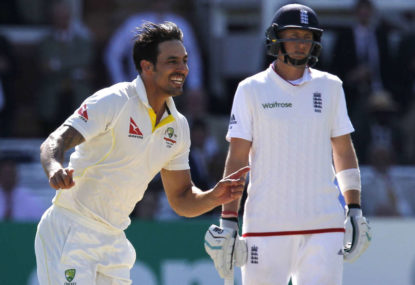Expert

Too many Tests are being dominated by the bat. Perhaps day-night matches, like Australia’s Test against New Zealand in Adelaide next month, can help correct the balance.
But before the format can flourish it will have to survive. At the moment it is under fire from cricket followers as well as players, who have voiced concerns about the poor visibility of the pink ball.
While it is impossible to predict what impact the day-night format will have on Test matches, there is evidence from the trials in Australian domestic cricket that it helps the bowlers.
Cricket Australia over the past two Sheffield Shield seasons set aside one round to trial the pink ball in day-night conditions.
Over those six Shield matches, the average first innings score was just 287. That was significantly lower than the average first innings total of 341 across the remainder of the games in those two seasons.
To further underscore the low-scoring nature of those day-night matches, only three times in 23 innings did a team exceed 300.
Bear in mind also that Shield pitches over the past two seasons have, by and large, been wonderful for batting, following the recent trend in international cricket.
So used to roads have international batsmen become that when there is movement through the air, or even worse off the pitch, we see some floundering efforts.
That was highlighted during the recent Ashes when Australia’s batsmen disgraced themselves on the two surfaces which offered a degree of assistance to the bowlers.
While few cricket followers want to see Tests over within three or four days, equally we hate to watch bowlers labour for five days forlornly on pitches as responsive as a cadaver.
Most of the recent changes in Test cricket have favoured batsmen – from shorter boundaries, to more powerful bats, restrictions on bouncers and, most of all, increasingly docile decks.
The introduction of day-night fixtures as a regular part of Test cricket could be a boost for pacemen, in particular.
All too often in recent years we have seen fast bowlers flogging their bodies on surfaces which render them impotent. The lifeless strip at Abu Dhabi for the first Test between Pakistan and England was a prime example.
Even with the new ball, the quicks got minimal pace, lift or carry and not a skerrick of seam movement.
Pakistan’s shambolic batting on the final day may have almost produced a result in the Test but don’t be fooled. It was a disgrace of a deck.
The pitches on which Australia played in the UAE last year were similarly poor. They were so sleepy that the two-match series should have been an extremely high-scoring 0-0 draw.
Only the ineptitude of the Australian batsmen against spin breathed any life into those Tests. It had nothing to do with the pitches, which offered zero to the tweakers either.
Spinners may not get any great joy from the day-night format but it seems that the poor old pacemen might.
Several Shield bowlers have noted the manner in which the pink ball swings early on, particularly under lights.
Western Australia left-armer Jason Behrendorff, who has played in all three of his team’s day-night Shield matches, highlighted this in an interview with cricket.com.au in June.
“I learned that if I can bowl with a newish pink ball under lights I’m very happy – it swings around a bit,” Behrendorff said.
“The thing about the pink ball is there’s definitely an advantage bowling at night. The ball swings around a bit more and even if it’s a bit older it still swings.
“And the balls were definitely improved this year (2014-15). The balls retain their shine a bit more and they changed the seam from white to green which might have helped the bowlers at night a bit.”
The current opening round of the Shield is being played under lights, as will the third Test against the Kiwis at Adelaide in four weeks’ time.
As the flattest Test pitch in Australia, Adelaide is a suitable venue for such a fixture. Based on Behrendorff’s assessment we could see some wicked swing bowling from the likes of Mitchell Starc and New Zealand’s quality new ball pair Trent Boult and Tim Southee.
A relatively low-scoring Adelaide Test controlled, for once, by the bowlers rather than the batsmen would make for a nice change.
Let’s just hope that the pink ball does not prove a hindrance to an innovation that has the potential to add considerable intrigue and fan appeal to Test cricket, not to mention a fairer balance between bat and ball.